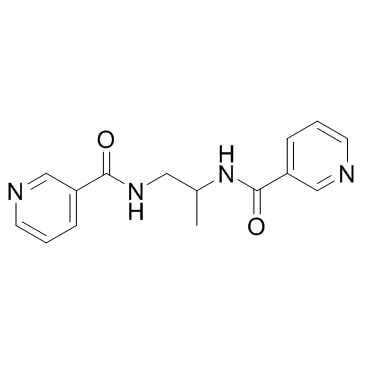79455-30-4
| Name | N-[2-(pyridine-3-carbonylamino)propyl]pyridine-3-carboxamide |
|---|---|
| Synonyms |
(+-)-N,N'-Propylenebis(nicotinamide)
1,2-Bis(nicotinamido)propane N,N'-propane-1,2-diyldipyridine-3-carboxamide Nicaraven N,N'-1,2-Propanediyldinicotinamide N,N'-Propylenenicotinamide N,N'-(Propane-1,2-diyl)dinicotinamide 3-Pyridinecarboxamide, N,N'-(1-methyl-1,2-ethanediyl)bis- N,N'-Propane-1,2-diyldinicotinamide (±)-N,N'-Propylenedinicotinamide N,N'-propylenedinicotinamide (±)-1,2-Bis(nicotinamido)propane Nicaravenum [INN-Latin] |
| Description | Nicaraven is a novel chemically synthesized hydroxyl radical-specific scavenger. |
|---|---|
| Related Catalog | |
| In Vitro | The maximum aggregation rate induced by adenosine diphosphate (ADP) is significantly inhibited by nicaraven at concentration ranges of 350 μM or higher in the healthy volunteer platelets. The maximum aggregation rate induced by collagen is significantly inhibited by 1.75 mM of nicaraven[1]. |
| In Vivo | Nicaraven inhibits lipid peroxidation in the liver, improves hepatic and systemic hemodynamics and energy metabolism, and suppresses liver enzyme release, endothelin-1 elevation in hepatic venous blood, histologic damage, and neutrophil infiltration into the liver[1]. Nicaraven increases the number of c-kit(+) stem/progenitor cells in bone marrow and peripheral blood, with a recovery rate around 60-90% of age-matched non-irradiated healthy mice. The potency of colony forming from hematopoietic stem/progenitor cells as indicator of function is completely protected with nicaraven treatment[2]. Administration of nicaraven significantly increases the number, improves the colony-forming capacity, and decreases the DNA damage of hematopoietic stem/progenitor cells. The urinary levels of 8-oxo-2′-deoxyguanosine, a marker of DNA oxidation, are significantly lower in mice that are given nicaraven compared with those that receive a placebo. The administration of nicaraven significantly decreases the levels of the inflammatory cytokines IL-6 and TNF-α in the plasma of mice[3]. |
| Animal Admin | Mice: To investigate the protective effect and related mechanisms of nicaraven on radiation-induced injury in hematopoietic stem/progenitor cells, 12 mice are exposed to 1 Gy γ-rays daily for 5 days in succession (a total of 5 Gy) and are then given intraperitoneal injections of nicaraven (100 mg/kg/day, Nicaraven group; n=6) or saline only (Placebo group; n=6), respectively, soon after each exposure. The mice are sacrificed 2 days after the last exposure, and samples of urine, blood, and bone marrow cells are collected and used for the following experiments[3]. |
| References |
| Density | 1.2±0.1 g/cm3 |
|---|---|
| Boiling Point | 635.9±40.0 °C at 760 mmHg |
| Molecular Formula | C15H16N4O2 |
| Molecular Weight | 284.313 |
| Flash Point | 338.4±27.3 °C |
| Exact Mass | 284.127319 |
| PSA | 83.98000 |
| LogP | 0.44 |
| Appearance | white solid |
| Vapour Pressure | 0.0±1.9 mmHg at 25°C |
| Index of Refraction | 1.584 |
| Storage condition | -20℃ |
CHEMICAL IDENTIFICATION
HEALTH HAZARD DATAACUTE TOXICITY DATA
|


